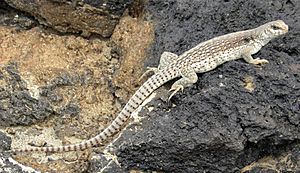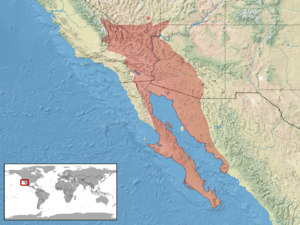Desert iguana facts for kids
Quick facts for kids Desert iguana |
|
|---|---|
 |
|
| Conservation status | |
| Scientific classification | |
| Genus: |
Dipsosaurus
|
| Species: |
dorsalis
|
 |
|
The desert iguana (Dipsosaurus dorsalis) is one of the most common lizards found in the hot, dry Sonoran Desert and Mojave deserts. These deserts are located in the southwestern United States and northwestern Mexico. You can also find them on several islands in the Gulf of California. Their color is usually grey and tan, which helps them blend in with their sandy homes.
Contents
Understanding the Desert Iguana's Name
The scientific name for the desert iguana is Dipsosaurus dorsalis. This name has a cool meaning!
What Dipsosaurus Means
The first part, Dipsosaurus, comes from two Greek words. "Dipsa" (δίψα) means "thirsty," and "sauros" (σαῦρος) means "lizard." So, Dipsosaurus basically means "thirsty lizard." This might be because they live in very dry places.
What Dorsalis Means
The second part of the name, "dorsalis," comes from the Latin word dorsum. This word means "spike" or "back." It refers to a row of slightly larger, spiky scales that run down the middle of the iguana's back. These scales form a small crest that goes almost to the tip of its tail.
How to Spot a Desert Iguana
Desert iguanas are medium-sized lizards. They can grow to about 24 inches (61 cm) long, including their tail.
Color and Pattern
Their bodies are usually a pale gray-tan or cream color. They have a light brown pattern on their backs and sides that looks a bit like a net. This pattern helps them hide in their desert environment. Near their back legs, the net-like pattern changes into brown spots. These spots then turn into stripes along their tail.
Special Scales and Tail
Down the center of their back, there is a row of slightly larger, keeled scales. These scales get a little bigger as you move down their back. Their belly is a pale color. During the breeding season, both male and female iguanas might get a pinkish color on their sides. Their tail is usually about one and a half times longer than their body.
Where Desert Iguanas Live
Desert iguanas prefer to live in dry, sandy desert scrubland. You'll often find them where creosote bushes grow. These areas are usually below 3,300 feet (1,000 meters) in elevation. They can also be found in rocky streambeds. In the southern parts of their range, they live in arid subtropical scrub and tropical dry forests.
Surviving the Heat
These lizards are very good at handling high temperatures. They can be active even when other lizards have gone to hide from the heat. When they feel threatened, they quickly scamper into a bush and then disappear into a burrow.
Their Homes Underground
Desert iguanas dig many burrows, usually under bushes like the creosote. They also sometimes use burrows dug by other animals, like kit foxes and desert tortoises. The warm temperatures in their habitat are also important for their eggs to hatch successfully. Their eggs often hatch best when the temperature is between 28 and 38 degrees Celsius.
What Desert Iguanas Eat and How They Reproduce
Desert iguanas are mostly herbivores, meaning they eat plants.
Their Diet
They enjoy eating the buds, fruits, and leaves of many different annual and perennial plants. They are especially fond of the bright yellow flowers of the creosote bush.
Raising Young
Mating for desert iguanas happens in the early spring. It is believed that they lay only one clutch of eggs each year. Each clutch usually has between 3 and 8 eggs. The baby iguanas, called hatchlings, usually come out of their eggs around September.
Who Eats Them?
Many animals prey on desert iguanas and their eggs. These predators include birds of prey, foxes, rats, long-tailed weasels, and some snakes. Humans can also be a threat.
See also
 In Spanish: Iguana del desierto para niños
In Spanish: Iguana del desierto para niños


